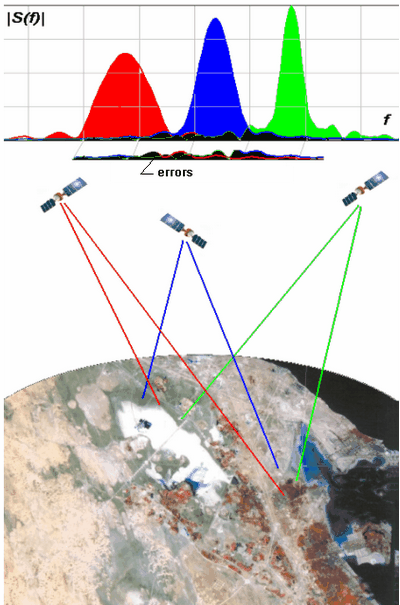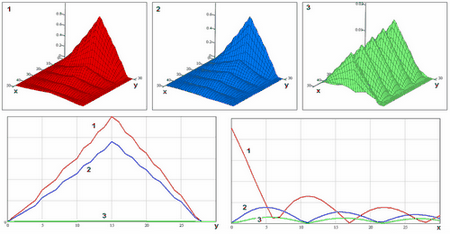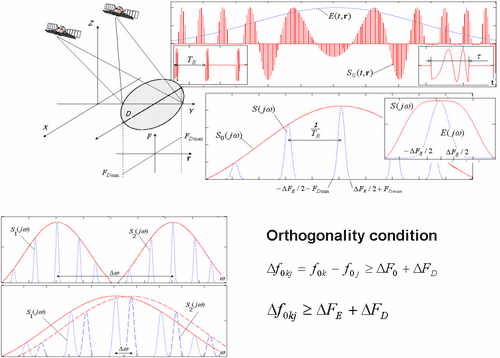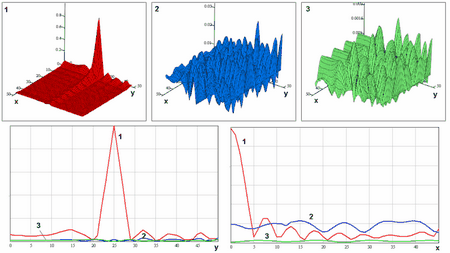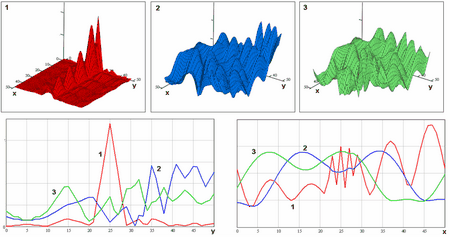|
|
Multiposition Synthetic Aperture Radar (MPSAR) Alexander V Ksendzuk |
|
|
|
| Main Page |
7. Signal Groups in Multiposition SAR.
7.1. Signal-to-noise ratio in multiposition SAR. Interchannel interference.
In multiposition Synthetic
Aperture Radar (MPSAR) interchannel interference effect on radar image quality.
To understand it lets derive output of the optimal processing algorithm
(matching filtering) for the arbitrary bistatic pair ōi-th receiver ¢ k-th
transmitterö Signal component is a signal of k-th transmitter, scattered from the surface and received by i-th receiver.
where
Noise component caused by presence of the additive noise
Interference component caused by signals, transmitted by other than ōk-thö transmitter, scattered from the surface and received by ōi-thö receiver:
|
| Signal Model | |
| Geometry | |
| Optimal Signal Processing | |
| Object detection | |
| Multiposition SAR interferometer | |
| Pseudonoise signals in remote sensing systems | |
| Pseudo-passive SAR | |
| Remote sensing systems modeling principles | |
| About Author | |
| Links | |
|
Therefore signal-to noise ratio in bistatic pair ōi-th receiver ¢ k-th transmitterö
significantly depends on interference level
An example of the interference noise in frequency domain is shown in Figure 7.1.
Figure 7.1. Interference noise in multiposition SAR, frequency domain.
For the simplified surface model (See Section 2, equation 2.4 ) interference level (7.2) transforms to
where
7.2. Signal orthogonality in multiposition SAR.
Complex signals
In multiposition SAR (MPSAR) this criterion is not sufficient because of spreading signal spectra caused by scattering from the surface and crafts movement. This means that we need to modify term ōorthogonalityö. Signals of k-th and j-th transmitters we will cal point-orthogonal in i-th receiver if condition
where
Function (7.4) is an interchannel space ambiguity function for bistatic pairs ōi-th receiver ¢ j-th transmitterö and ōi-th receiver ¢ k-th transmitterö, its level allows to estimate errors, caused by non-orthogonality of the signals. Investigation of this function is necessary for radar image quality estimation.
Signals of k-th and j-th
transmitters we will call orthogonal in surface
for any
7.3. Signal groups in multiposition SAR. Carrier frequency separation. Signals with carrier frequency separation.
characterizes by interchannel space ambiguity function
value of which decreases when
difference
Figure 7.2.
Interchannel space ambiguity function for the signals with different carrier
frequencies, difference
Signals will be orthogonal
In practice, it is necessary to
decrease bandwidth of the MPSAR signal. If condition
Figure 7.3. Signal and its spectra for the bistatic pair. Orthogonality condition. 7.4. Signal groups in multiposition SAR. Envelope (code) separation. For the envelope separation signals differ by complex envelope (or buy code for digital signals)
Interchannel space ambiguity
function
canÆt be decreased as much as possible only by envelopes (codes) selection, Figure 7.4. But this kind of ensemble allows to decrease MPSAR bandwidth as much as possible.
Figure 7.4. Interchannel space ambiguity function for the signals with different envelopes. 7. 5. Signal groups in multiposition SAR. Envelope and carrier frequency separation. For this signal group signals differ by carrier frequency and by envelope (or code for digital signals) simulateneously
This kind of separation and corresponding signal ensemble allows to achieve low level of interchannel interference (7.3) and decrease bandwidth of Multiposition SAR signals, Figure 7.5.
Figure 7.5. Interchannel space ambiguity function for the signals with frequency (graph 1), code (graph 2) and code-frequency (graph 3) separation.
Conclusion. Signal groups selection in multiposition SAR must be based on signal-to-noise ratio, which takes into account interchannel interference. This interference component of the optimal processor output caused by signals, transmitted by other than ōk-thö transmitter, scattered from the surface and received by ōi-thö receiver. Signal groups (carrier frequency separation, envelope separation, carrier frequency and envelope separation) must be chosen for certain MPSAR spatial configuration because value of the interchannel interference depends on interchannel space ambiguity function, which is depends on spatial configuration. In general case (for signals finite in frequency domain) it is possible to provide orthogonality of the equal signals only by spatial configuration variation. This means that it is necessary to do simultaneous optimization of the signal groups, and spatial configuration of the multiposition SAR must be based on criteria, which involve interchannel interference (7.3) or signal-to-noise ratio (7.1):
|
|
e-mail to author: Alexander V Ksendzuk |






